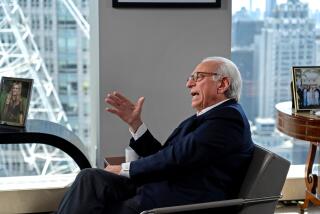‘Fade Out’: Peter Bart in the Lion’s Den : Film: Former MGM/UA executive chronicles the decline of the once-powerful studio.
In 1982, the book “Indecent Exposure” zeroed in on forgeries and embezzlement by then-Columbia Pictures production chief David Begelman. Three years later, “Final Cut” documented how spiraling costs on the film “Heaven’s Gate” triggered the downfall of United Artists.
Now comes “Fade Out: The Calamitous Final Days of MGM,” an examination by former MGM/UA senior vice president Peter Bart of the decline of the Culver City studio under the 20-year aegis of financier Kirk Kerkorian. Photocopied galleys of the book (to be published by William Morrow on June 25) are making the rounds of Hollywood’s executive suites, and those caught in Bart’s sights are firing back.
“A year after leaving the studio in 1985, observing all the deals Kerkorian was making, I realized there was a good story that hadn’t been told,” says Bart, a former New York Times reporter whose 22 years in Hollywood also included production stints at Paramount and Lorimar. He is now in New York as editor of weekly Variety.
“The potential was underscored by the fact that Kirk himself is an almost Howard Hughes-like figure who I had the privilege of knowing and spending time with to a degree. This is the first inside glimpse into the actions and motivations of the country’s least-known movie mogul.”
Among Bart’s allegations:
* Kerkorian sold off studio assets and “transformed corporate demolition into a high art,” becoming in the eyes of many in the film community, a “one-man wrecking crew.”
* In 1973 and 1975, Kerkorian “engineered huge dividend payouts” from the wobbly MGM, netting him $11.1 million to meet payments on bank loans for real estate ventures.
* In mid-’84, Kerkorian quietly threw his weight behind a raid conducted against Disney by Saul J. Steinberg which, had it succeeded, would have given Kerkorian the Disney film production business for $447.5 million.
Kerkorian’s studio heads are also targeted. Jim Aubrey (who renamed MGM’s Thalberg Building “The Administration Building” and removed a bust of the legendary head of production) routinely re-edited films, often tacking tunes onto the beginning or end without the knowledge of the director.
Frank Yablans, whom Bart describes as “one of the most colorful and interesting men in the movie business,” is painted as a coarse personality fixated on status. Yablans was said to have performed a “dog-and-pony show” for investors to interest them in “MGM bonds” (an effort orchestrated by indicted junk bond king Michael Milken) and, during his reign, was reportedly responsible for $250 million worth of “losing films,” according to the book.
Managerial bungling, observes Bart, was highlighted by the studio’s choice of releases. “It was the studio that almost made ‘Jaws,’ ‘The Sting,’ ‘Terms of Endearment,’ ‘Last Tango in Paris,’ ‘Dirty Dancing’ and ‘Crocodile Dundee,”’ he writes, while going ahead with such expensive flops as “Mrs. Soffel,” and “2010.”
“Kirk took a Vegas approach to the situation,” says Bart. “He kept looking for the lucky combination of executives and, if the game wasn’t going well, would just keep on rolling. He rolled so many times that it was self-destructive and led to the studio’s demise.”
About his Hollywood years, Bart says “being inside a studio is an emotional cauldron--so little product getting through, so much riding on every decision, everything right on the edge. An almost surrealist backdrop to every film. ‘Fade Out,’ as I see it, is a funny book . . . so outrageous, it’s comical.”
Producer Freddie Fields (“Glory”)--a one-time head of MGM--calls the book “a joke,” alluding more to the book’s purported inaccuracies than to the author’s sense of humor. He declined to comment further.
Says a spokesman for producer Jerry Weintraub, whom Bart portrays as megalomaniacal and inept during his stint at United Artists: “Of the part I read, 50% of it is patently untrue . . . and half of the other half is distorted.”
Kerkorian, because he has yet to read the book, says he cannot address its “content and factuality.” He points out, however, that Bart’s charges of decimating the studio are nothing new. “For some time, I have been accused of breaking up MGM when, in fact, for 20 years, I have worked to build, strengthen, and expand the company. All of MGM was sold at one time, to Ted Turner in March of 1986, not piecemeal as has erroneously been repeatedly reported.”
Critics of Bart’s book have mounted their own list of allegations:
* Most of Bart’s recollections of meetings of top brass were taken from hearsay, says a spokesman for Weintraub. (Says Bart: “I was present at some of the meetings. At those that I wasn’t, my sources were knowledgeable and informed. All you can do is go to the top and assume you’re getting the right answers.”)
* Bart, said another insider, was a “third-rate executive” who, despite his suggestion in the book that he resigned, had been fired from the studio--a fact that was bound to color his perceptions. (“I didn’t portray myself as a genius and I assumed that the company was as disappointed with the way things were working as I. But I went in to ask Yablans for a producing deal. No one called me in.”)
* Bart’s book betrays Yablans who considered him his “best friend,” another producer said. (“I have great affection for Frank, but we weren’t close personal friends. We never hung out together. I never intended this to be a slam at Frank and it would disappoint me if it was interpreted that way. Frank tried hard. He was a victim, too.”)
Bart professes to have had no second thoughts about embarking on the project. “MGM/UA is a publicly held company run by people who pay a lot of money to publicists to make them public figures,” he says. “Studios in general tend to be cold, business-like environments, in no way resembling a family. This book is just an extension of the dog-eat-dog mentality that pervaded the place.”
Fields and Weintraub have both sent letters of protest to the publisher, claiming the work is riddled with inaccuracies. Weintraub labeled “Fade Out” “defamatory . . . a reckless disregard of truth and subject to liability.”
“No one at Morrow is quaking,” Bart says. “If the letters were written to intimidate, they were a definite failure. The book stays to carefully documented material and this kind of static is inevitable. Most of the calls I’m getting are from people--including one studio chief--happy that I wrote about what happened to two great companies, MGM and UA . . . not telling me that If I showed my face in town I’d get shot.”
More to Read
Sign up for our Book Club newsletter
Get the latest news, events and more from the Los Angeles Times Book Club, and help us get L.A. reading and talking.
You may occasionally receive promotional content from the Los Angeles Times.






